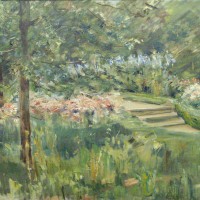-
Israel Museum Restitutes Important Nazi-Looted Liebermann Landscape
06/10/2013
 In 1941, Max Liebermann’s landscape masterpiece, Garden in Wansee (1923) was seized by the Einsatzstab Reichsleiter Rosenberg, a Nazi art-confiscation agency, from the collection of Jewish businessman, Max Cassirer. Recently, the Israel Museum in Jerusalem announced that it had restituted the painting to Cassirer’s heir. As per the settlement, the Museum returned the painting to the heir and then re-acquired it, allowing it to remain in the Museum’s collection, accessible to the public.
In 1941, Max Liebermann’s landscape masterpiece, Garden in Wansee (1923) was seized by the Einsatzstab Reichsleiter Rosenberg, a Nazi art-confiscation agency, from the collection of Jewish businessman, Max Cassirer. Recently, the Israel Museum in Jerusalem announced that it had restituted the painting to Cassirer’s heir. As per the settlement, the Museum returned the painting to the heir and then re-acquired it, allowing it to remain in the Museum’s collection, accessible to the public.
Persecuted by the Nazis, Cassirer was forced to sell his business to a German company in 1935. Four years later he fled to Switzerland, ultimately settling in England. His assets, including his art collection, were confiscated by the Nazis in 1941.
After the war, the painting passed through the Munich Central Collecting Point, where it was transferred to the Jewish Restitution Successor Organization (JRSO), which distributed heirless and unclaimed looted art and Judaica to museums, synagogues, and other Jewish organizations in Israel and throughout the world. Some of these objects were deposited in the Bezalel National Museum, the precursor to the Israel Museum, which, following its establishment in 1955, became the custodian of about 1,200 works of art and objects of Judaica acquired through JRSO. An online catalogue of the JRSO works currently in the custody of the Israel Museum can be found on its website.
In 2008, Garden in Wansee was featured in “Orphaned Art,” the Israel Museum’s landmark exhibition that explored the fate of looted artworks that were subsequently brought to Israel. Other works recently restituted by the Museum include another Liebermann painting, The Return of Tobias (returned to the artist’s heirs in 2011); Paul Klee’s drawing, Veil Dance (returned to the estate of German collector Harry Fuld, Jr. in 2010); Degas’ drawing, Four Nude Female Dancers Resting (returned to the heirs of Dutch art dealer Jacques Goudstikker in 2005); and Pissarro’s Boulevard Montmartre (returned to the heir of wealthy collector and Holocaust victim Max Silberberg). These efforts, along with the Museum’s history of significant restitutions, illustrate its commitment to provenance research and restitution.
Art Law Blog
